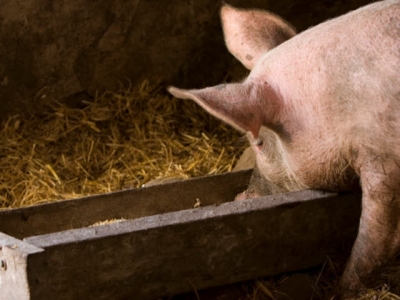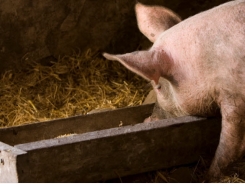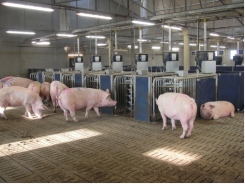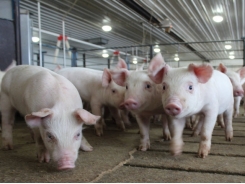Can neotame boost swine feed intake?

Low-calorie sweetener use may prompt greater feed intake and growth rate for weaned pigs.
A team of Chinese researchers examined the sweetening agent neotame in the diets of weaned piglets to understand how it would influence diet preference, pig performance, hematological and biochemical development of piglets.
The group ran a series of three experiments with the sweetener to see how pigs responded and how they performed when it was included in their diets. This is the first such study for the sweetener, which could increase the palatability of feed for just weaned piglets.
In a preference comparison, piglets preferred feed with the sweetener, said researchers. “The optimal concentrations of dietary neotame for maximum [average daily feed intake] ADFI and [average daily gain] ADG was ranged from 18.0 to 20.4 mg/kg during phase I (d 1–22), 22.0 to 22.9 mg/kg during phase II (d 23–35) and 20.7 to 21.7 mg/kg during entire experimental period (d 1–35), and no adverse effects on indicators of health were observed in pigs offered diets with neotame levels up to 500 mg/kg,” they added.
Why sweetener
Several factors of production add stress to young, weaned piglets, said researchers. That stress can result in reduced feed intake, diarrhea and limited growth.
“When the appetite of pigs is suppressed due to diet, environment and social change at weaning, taste and diet palatability will play essential roles in determining feed intake of weaned piglets (Kyriazakis and Emmans, 1999),” they said. “Diet changes can lead to poor palatability for piglets during the weaning period, which could be partly counteracted by sweetener supplement (Lewis et al., 1955 and Jacela et al., 2010).”
Neotame is a ‘non-nutritive artificial sweetener,’ they said. It is approximately 7,000-13,000 times sweeter than sucrose and 30-60 times sweeter than aspartame.
Previous studies in rodents, dogs, rabbits and humans have indicated that the product is not carcinogenic and does not cause reproductive or developmental damage, said researchers. However, it has not been tested as an additive for pig feed.
Experiment details
In a feed preference experiment, a group of 48 weaned piglets were divided into multiple pens and offered one of two diets, said researchers. Diets included a maize and soybean meal-based diet and the same diet with 30 mg/kg neotame added.
The amount eaten was established daily to measure feed intake and calculate diet preference percentage, they said. Pigs were offered the competing diets for a period of 15 days.
In the second experiment, 216 piglets were divided into six treatments getting diets that included 0, 10, 20, 30, 40 or 50 mg/kg neotame, they said. Pigs were on the trial feeds for two periods, 1-22 days and 23-35 days, lasting a total of 35 days.
In the final experiment, 108 piglets were evaluated for hematological and biochemical parameters, said researchers. Piglets were given one of three diets, a basal diet and ones containing 50 or 500 mg/kg neotame, for 35 days.
Blood samples were taken on day 36 and checked for hematological parameters, they said. And, 18 pigs were weighed, their organs were collected and tested for ratio to body mass and for morphological examination.
Results
In the preference experiment, piglets preferred the sweetened diet on several individual days and over the course of the experiment, said the scientists.
In the second feeding experiment, piglet ADFI increased linearly as additional amounts of neotame were added to their diet for both the first phase and entire time period, they said.
A quadratic effect was noted on ADG and ADFI during the first phase, second phase, and the entire period, they said.
“The optimal concentrations of dietary neotame to maximize ADG and ADFI during entire experimental period using a fitted quadratic plot model were 21.7 and 20.7 mg/kg, respectively,” they said.
In the third experiment, no differences were seen for blood factors, organ index and morphology with any of the three diets, they said.
“Normal histological structures in the liver and kidney were observed in all pigs fed the different diets for 35 days,” they said. “The results suggest that neotame has no measurable damage to the liver and kidney in piglets.”
Related news
Tools

Phối trộn thức ăn chăn nuôi

Pha dung dịch thủy canh

Định mức cho tôm ăn

Phối trộn phân bón NPK

Xác định tỷ lệ tôm sống

Chuyển đổi đơn vị phân bón

Xác định công suất sục khí

Chuyển đổi đơn vị tôm

Tính diện tích nhà kính

Tính thể tích ao




 Marine algae may inhibit bacterial growth in pigs
Marine algae may inhibit bacterial growth in pigs  Essential oils, diet may boost piglet growth, gut…
Essential oils, diet may boost piglet growth, gut…